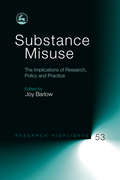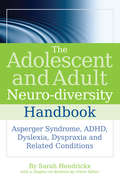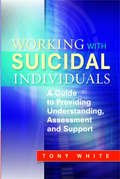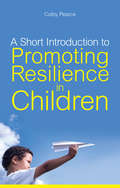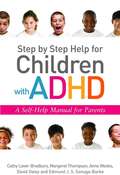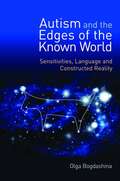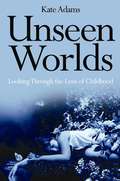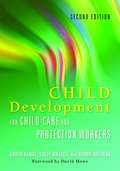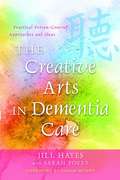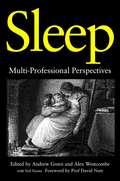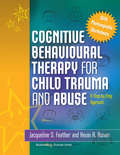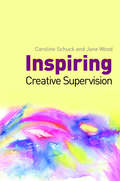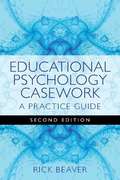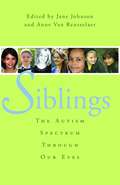- Table View
- List View
Substance Misuse: The Implications of Research, Policy and Practice (PDF)
by Anne Bryce Bernadette Monaghan Brian Kidd Charlie Llyod Donald Forrester Gerard Vaughn Harry Sumnall Jack Law James Egan Jane Fountain Jo Neale Joy Barlow Joyce Nicholson Linda Mckie Lisa Jones Margaret Black Maurizio Coletti Megan Larken Neil Hunter Neil Mckeganey Peter Kemp Richard Ives Sally Haw Toby Seddon Viv EvansSubstance misuse and its pervasive problems is a constant challenge for social work, health and related professionals today. With heightened political and policy emphasis on all aspects of substance misuse, it is paramount that professionals remain up-to-date on current issues and their responsibilities. Based on research and evidence, this book provides a sound basis for grounded and innovative practice. Leading international contributors outline holistic and specialist approaches to policy and practice, and highlight the shift in emphasis from immediate risk minimisation to long-term recovery, the importance of prevention and the pivotal role of workforce development. Issues surrounding work with children and families affected by substance misuse are explored, and ways of implementing new approaches revealed. The book also looks at the impact of the smoking ban in Scotland, and suggests ways to support tobacco use cessation. This book is essential reading for all front-line practitioners working with substance misusers, including social work, health professionals and counsellors.
The Adolescent and Adult Neuro-diversity Handbook: Asperger Syndrome, ADHD, Dyslexia, Dyspraxia and Related Conditions
by Claire Salter Sarah HendrickxIncreasing numbers of adults are realising that they have been living with an undiagnosed developmental condition, yet most information and support focuses on children. This leaves many adults confused and in the dark. The Adolescent and Adult Neuro-Diversity Handbook is a handy first-reference point guide to the full range of developmental conditions as they affect adolescents and adults. Each chapter focuses on a different condition, describing its history, causes and characteristics, its implications for the individual, diagnosis and assessment, treatments and approaches, and strategies for providing support and self-support. A wide range of conditions are covered, including Autistic Spectrum Disorders, Dyslexia, Dyspraxia, ADHD, OCD, Tourette's and Anxiety Disorders. The Adolescent and Adult Neuro-Diversity Handbook is an invaluable resource for health and social care practitioners, as well as for individuals who feel that they may be living with an undiagnosed developmental condition.
The Adolescent and Adult Neuro-diversity Handbook: Asperger Syndrome, ADHD, Dyslexia, Dyspraxia and Related Conditions (PDF)
by Claire Salter Sarah HendrickxIncreasing numbers of adults are realising that they have been living with an undiagnosed developmental condition, yet most information and support focuses on children. This leaves many adults confused and in the dark. The Adolescent and Adult Neuro-Diversity Handbook is a handy first-reference point guide to the full range of developmental conditions as they affect adolescents and adults. Each chapter focuses on a different condition, describing its history, causes and characteristics, its implications for the individual, diagnosis and assessment, treatments and approaches, and strategies for providing support and self-support. A wide range of conditions are covered, including Autistic Spectrum Disorders, Dyslexia, Dyspraxia, ADHD, OCD, Tourette's and Anxiety Disorders. The Adolescent and Adult Neuro-Diversity Handbook is an invaluable resource for health and social care practitioners, as well as for individuals who feel that they may be living with an undiagnosed developmental condition.
Working with Suicidal Individuals: A Guide to Providing Understanding, Assessment and Support
by Tony White*Highly Commended in the Psychiatry Category of the 2011 BMA Book Awards* Working with Suicidal Individuals provides a comprehensive guide to understanding suicide, the assessment of risk, and the treatment and management of suicidal individuals. It begins by covering the theory behind suicidal behaviour, using Transactional Analysis to explore the personality types of suicidal individuals and to understand their motivations. Factors that contribute to an individual becoming suicidal, such as mental illness, are also explored. A comprehensive system for the assessment of suicide risk is provided, including both quantitative and qualitative approaches. Finally, the author discusses different ways suicidal and pseudo-suicidal individuals can be managed and treated, including the 'no suicide contract' and redecision therapy. Case studies are included throughout to demonstrate the theory and practice. This book will be essential reading for all those working with a suicidal or at-risk individual, including practitioners in health, social work, psychotherapy, psychology and counselling.
Working with Suicidal Individuals: A Guide to Providing Understanding, Assessment and Support (PDF)
by Tony White*Highly Commended in the Psychiatry Category of the 2011 BMA Book Awards* Working with Suicidal Individuals provides a comprehensive guide to understanding suicide, the assessment of risk, and the treatment and management of suicidal individuals. It begins by covering the theory behind suicidal behaviour, using Transactional Analysis to explore the personality types of suicidal individuals and to understand their motivations. Factors that contribute to an individual becoming suicidal, such as mental illness, are also explored. A comprehensive system for the assessment of suicide risk is provided, including both quantitative and qualitative approaches. Finally, the author discusses different ways suicidal and pseudo-suicidal individuals can be managed and treated, including the 'no suicide contract' and redecision therapy. Case studies are included throughout to demonstrate the theory and practice. This book will be essential reading for all those working with a suicidal or at-risk individual, including practitioners in health, social work, psychotherapy, psychology and counselling.
A Short Introduction to Promoting Resilience in Children
by Colby PearceA child's capacity to cope with adversity and 'stand on their own two feet' is seen as critical to their development, well-being, and future independence and success in adulthood. Psychological strength, or resilience, directly affects a child's capacity to cope with adversity. This book provides a succinct, accessible and clear guide on how to promote resilience in children and achieve positive developmental outcomes for them. The author covers three key factors that affect resiliency: vulnerability to stress and anxiety, attachment relationships, and access to basic needs. For each, the author presents practical advice and strategies, such as how to regulate children's stress and anxiety, how to encourage and maintain secure attachments, and how to assure children that their needs are understood and will be met. The model presented will help parents and carers ensure their children grow up happy, healthy and resilient. This book will be invaluable for parents, carers and practitioners in supportive roles caring for children.
A Short Introduction to Promoting Resilience in Children (PDF)
by Colby PearceA child's capacity to cope with adversity and 'stand on their own two feet' is seen as critical to their development, well-being, and future independence and success in adulthood. Psychological strength, or resilience, directly affects a child's capacity to cope with adversity. This book provides a succinct, accessible and clear guide on how to promote resilience in children and achieve positive developmental outcomes for them. The author covers three key factors that affect resiliency: vulnerability to stress and anxiety, attachment relationships, and access to basic needs. For each, the author presents practical advice and strategies, such as how to regulate children's stress and anxiety, how to encourage and maintain secure attachments, and how to assure children that their needs are understood and will be met. The model presented will help parents and carers ensure their children grow up happy, healthy and resilient. This book will be invaluable for parents, carers and practitioners in supportive roles caring for children.
Step by Step Help for Children with ADHD: A Self-Help Manual for Parents
by Anne Weeks Cathy Laver-Bradbury David Daley E Sonuga-Barke Margaret ThompsonRaising a child with ADHD can be distressing and exhausting for the whole family. But given the appropriate knowledge, and the right tools, parents can intervene to manage their child's behaviour, leading to improved relationships at home and, it is hoped, a more successful time at school. This simple, flexible six-step programme is full of tried-and-tested ideas for parents and professionals supporting families of young children with ADHD. By practicing the techniques and strategies, parents will gain confidence in their parenting and, over time, will improve the child’s management of the condition. The programme includes games that will help improve the child’s attention, exercises to develop patience and tips for supporting the child in successful self-organization. There are also plenty of useful ideas for developing communication between parents and schools. Based on research and extensive clinical experience, Step by Step Help for Children with ADHD will help families to adapt their parenting to the child, improving relationships and behaviours in the home and at play group.
Step by Step Help for Children with ADHD: A Self-Help Manual for Parents (PDF)
by Anne Weeks Cathy Laver-Bradbury David Daley E Sonuga-Barke Margaret ThompsonRaising a child with ADHD can be distressing and exhausting for the whole family. But given the appropriate knowledge, and the right tools, parents can intervene to manage their child's behaviour, leading to improved relationships at home and, it is hoped, a more successful time at school. This simple, flexible six-step programme is full of tried-and-tested ideas for parents and professionals supporting families of young children with ADHD. By practicing the techniques and strategies, parents will gain confidence in their parenting and, over time, will improve the child’s management of the condition. The programme includes games that will help improve the child’s attention, exercises to develop patience and tips for supporting the child in successful self-organization. There are also plenty of useful ideas for developing communication between parents and schools. Based on research and extensive clinical experience, Step by Step Help for Children with ADHD will help families to adapt their parenting to the child, improving relationships and behaviours in the home and at play group.
Autism and the Edges of the Known World: Sensitivities, Language and Constructed Reality (PDF)
by Olga Bogdashina Kazik Hubert Theo PeetersIn this intelligent and incisive book, Olga Bogdashina explores old and new theories of sensory perception and communication in autism. Drawing on linguistics, philosophy, neuroscience, psychology, anthropology and quantum mechanics, she looks at how the nature of the senses inform an individual's view of the world, and how language both reflects and constructs that view. Examining the 'whys' and 'hows' of the senses, and the role of language, Olga Bogdashina challenges common perceptions of what it means to be 'normal' and 'abnormal'. In doing so she shows that autism can help to illuminate our understanding of what it means to be human, and of how we develop faculties that shape our cognition, language, and behaviour. In the final chapter, she explores phenomena often associated with the paranormal - including premonitions, telepathy and déjà vu - and shows that these can largely be explained in natural terms. This book will appeal to anyone with a personal or professional interest in autism, including students and researchers, clinical practitioners, individuals on the autism spectrum and their families, teachers, speech and occupational therapists, and other professionals.
Unseen Worlds: Looking Through the Lens of Childhood
by Kate AdamsThe child's world often revolves around dreams and fantasy. Imaginary friends, places and play can seem entirely real, and yet in dismissing these as 'just your imagination', many adults cut a tie that can be the key to understanding a child. Unseen Worlds explores children's experiences of creative play, fairies, angels, imaginary friends, dreams and seeing deceased relatives alongside the more frightening realms of nightmares and the unexplained. It breaks new ground by giving voice to children of various ages to express how they encounter these different worlds and why they often keep them a secret. Kate Adams emphasises that whilst many adults forget what it feels like to be a child, developing a little empathy and understanding can enhance relationships with children and lead to positive change, both in parenting and professional practice. This insightful book will be of great interest to educators, counsellors, youth and community workers, childcare providers, parents and anybody else who seeks to understand, nurture, and strengthen relationships with children of all ages.
Unseen Worlds: Looking Through the Lens of Childhood (PDF)
by Kate AdamsThe child's world often revolves around dreams and fantasy. Imaginary friends, places and play can seem entirely real, and yet in dismissing these as 'just your imagination', many adults cut a tie that can be the key to understanding a child. Unseen Worlds explores children's experiences of creative play, fairies, angels, imaginary friends, dreams and seeing deceased relatives alongside the more frightening realms of nightmares and the unexplained. It breaks new ground by giving voice to children of various ages to express how they encounter these different worlds and why they often keep them a secret. Kate Adams emphasises that whilst many adults forget what it feels like to be a child, developing a little empathy and understanding can enhance relationships with children and lead to positive change, both in parenting and professional practice. This insightful book will be of great interest to educators, counsellors, youth and community workers, childcare providers, parents and anybody else who seeks to understand, nurture, and strengthen relationships with children of all ages.
Child Development for Child Care and Protection Workers: Second Edition
by Brigid Daniel Robbie Gilligan Sally WassellChild Development for Child Care and Protection Workers is a classic text for students and practitioners in the child care and protection field which summarises important current thinking on child development and applies it directly to practice. The book covers key issues such as resilience and vulnerability and the impact of protective or adverse environments. Different stages of development (infancy, school age and adolescence) are discussed, and attachment theory is used to offer insights into the impact of abuse and neglect on development. A key feature is the inclusion of case studies and activities to allow the reader to improve their understanding and reflect on good practice. This second edition is fully updated to reflect the new policy context and multi-disciplinary practice, and contains updated practice examples to take into account contemporary issues affecting children and young people. This book encourages practitioners to consider each child as an individual with unique circumstances, and links theory and practice in an imaginative and sympathetic way. It will be essential reading for all child care and protection workers.
Child Development for Child Care and Protection Workers: Second Edition (PDF)
by Brigid Daniel Robbie Gilligan Sally WassellChild Development for Child Care and Protection Workers is a classic text for students and practitioners in the child care and protection field which summarises important current thinking on child development and applies it directly to practice. The book covers key issues such as resilience and vulnerability and the impact of protective or adverse environments. Different stages of development (infancy, school age and adolescence) are discussed, and attachment theory is used to offer insights into the impact of abuse and neglect on development. A key feature is the inclusion of case studies and activities to allow the reader to improve their understanding and reflect on good practice. This second edition is fully updated to reflect the new policy context and multi-disciplinary practice, and contains updated practice examples to take into account contemporary issues affecting children and young people. This book encourages practitioners to consider each child as an individual with unique circumstances, and links theory and practice in an imaginative and sympathetic way. It will be essential reading for all child care and protection workers.
The Creative Arts in Dementia Care: Practical Person-Centred Approaches and Ideas
by Jill Hayes Sarah Povey Shaun McniffThe physical care of people with dementia is of vital importance, but so too is their emotional, social, mental and spiritual wellbeing. The creative arts are gaining increasing recognition not only as a tool for delivering effective person-centred dementia care, but also for attending to soul as well as body. Encouraging those who care for people with dementia to develop their own creative skills, this book provides a creative map of care with easy-to-follow examples and detailed case studies. After explaining why adopting a creative approach is central to effective dementia care, the authors go on to discuss meditation, singing, movement and storytelling, describing the therapeutic benefits of each and giving practical examples of how they can be used with individuals or groups. They also look at the importance of creative supervision in promoting creativity and creating a safe space for honest interpersonal connection: an essential foundation for effective teamwork. This book will be an invaluable resource for anyone involved in the care of a person with dementia, including professional staff in residential and nursing homes, hospitals and day centres, families and other non-professional carers.
The Creative Arts in Dementia Care: Practical Person-Centred Approaches and Ideas (PDF)
by Jill Hayes Sarah Povey Shaun McniffThe physical care of people with dementia is of vital importance, but so too is their emotional, social, mental and spiritual wellbeing. The creative arts are gaining increasing recognition not only as a tool for delivering effective person-centred dementia care, but also for attending to soul as well as body. Encouraging those who care for people with dementia to develop their own creative skills, this book provides a creative map of care with easy-to-follow examples and detailed case studies. After explaining why adopting a creative approach is central to effective dementia care, the authors go on to discuss meditation, singing, movement and storytelling, describing the therapeutic benefits of each and giving practical examples of how they can be used with individuals or groups. They also look at the importance of creative supervision in promoting creativity and creating a safe space for honest interpersonal connection: an essential foundation for effective teamwork. This book will be an invaluable resource for anyone involved in the care of a person with dementia, including professional staff in residential and nursing homes, hospitals and day centres, families and other non-professional carers.
Sleep: Multi-Professional Perspectives
by Alex Westcombe Andrew Green Brigitte Steger Caroline Jones Dietmar Hank Hazel O'Dowd Helen Ball Katharina Wulff Lee Scrivner Louise Paterson Nigel Hudson Robert Meadows Stephen Jacobs Sue Wilson Ved P VarmaThis book brings together an unprecedented number and range of contributions from different disciplines relating to sleep in one comprehensive volume. The contributors explore the science of sleep - what it is, what makes it happen and why we do it - as well as the measurement of sleep, its importance for daytime performance and its sociological and cultural aspects. Sleep disorders, sleep quality and the importance of sleep for daytime performance are also explored, as are the ways in which sleep can be affected by medication and medical and psychiatric conditions. This groundbreaking and insightful book will be of great interest to students, academics and professionals in a wide range of disciplines, and anyone else who wishes to discover more about this fascinating topic.
Sleep: Multi-Professional Perspectives (PDF)
by Alex Westcombe Andrew Green Brigitte Steger Caroline Jones Dietmar Hank Hazel O'Dowd Helen Ball Katharina Wulff Lee Scrivner Louise Paterson Nigel Hudson Robert Meadows Stephen Jacobs Sue Wilson Ved P VarmaThis book brings together an unprecedented number and range of contributions from different disciplines relating to sleep in one comprehensive volume. The contributors explore the science of sleep - what it is, what makes it happen and why we do it - as well as the measurement of sleep, its importance for daytime performance and its sociological and cultural aspects. Sleep disorders, sleep quality and the importance of sleep for daytime performance are also explored, as are the ways in which sleep can be affected by medication and medical and psychiatric conditions. This groundbreaking and insightful book will be of great interest to students, academics and professionals in a wide range of disciplines, and anyone else who wishes to discover more about this fascinating topic.
Cognitive Behavioural Therapy for Child Trauma and Abuse: A Step-by-Step Approach
by Jacqueline S. Feather Kevin RonanThe effects of trauma and abuse on children can be long-lasting, acute and damaging. Evidence suggests that cognitive behavioural therapy (CBT) is a highly effective form of psychotherapy to help children to overcome these effects. This book uses an evidence-based CBT treatment model to assist children and adolescents aged 9–15 years to resolve trauma symptoms and increase their coping skills. The approach is made up of 16 step-by-step sessions to carry out with the young person, and includes worksheets and fun activities using arts and crafts. The model uses four phases: strengthening the child's psychosocial context; enhancing their coping skills; processing their trauma through gradual exposure; and addressing special issues that the child may have and preventing relapse. The child keeps a scrapbook for the duration of the programme in which they keep worksheets, artwork and any other activities they carry out. The approach is designed for individual therapy but also includes sessions for parents and caregivers. With photocopiable worksheets and easy to follow sessions, this will be an invaluable resource for all practitioners working with traumatised and abused children, including therapists, psychologists, counsellors, health professionals and social workers.
Cognitive Behavioural Therapy for Child Trauma and Abuse: A Step-by-Step Approach (PDF)
by Jacqueline S. Feather Kevin RonanThe effects of trauma and abuse on children can be long-lasting, acute and damaging. Evidence suggests that cognitive behavioural therapy (CBT) is a highly effective form of psychotherapy to help children to overcome these effects. This book uses an evidence-based CBT treatment model to assist children and adolescents aged 9–15 years to resolve trauma symptoms and increase their coping skills. The approach is made up of 16 step-by-step sessions to carry out with the young person, and includes worksheets and fun activities using arts and crafts. The model uses four phases: strengthening the child's psychosocial context; enhancing their coping skills; processing their trauma through gradual exposure; and addressing special issues that the child may have and preventing relapse. The child keeps a scrapbook for the duration of the programme in which they keep worksheets, artwork and any other activities they carry out. The approach is designed for individual therapy but also includes sessions for parents and caregivers. With photocopiable worksheets and easy to follow sessions, this will be an invaluable resource for all practitioners working with traumatised and abused children, including therapists, psychologists, counsellors, health professionals and social workers.
Inspiring Creative Supervision
by Caroline Schuck Jane WoodCreative supervision can be a stimulating and valuable alternative to questioning and discussion in the context of a supervision session. This book proposes using many different techniques and materials, as well as the rich experience of the imagination and the senses, and encourages the reader to go beyond the formal demands of their role, and feel inspired by creativity, spontaneity and experiential work. The authors draw together theory, research and practical exercises, and provide ideas for setting up and running creative supervision sessions, including how to get started. The ideas and techniques outlined in this book include the use of narrative, drawings and visualisation, and the authors also clearly explain how to make the best use of props and resources such as toys, objet trouvé and picture postcards. The innovative approach described in this book will be of interest to supervisors and non-supervisors alike. It will serve as a road map for expressive arts therapists, social workers, psychotherapists, psychologists and mental health and health care workers, and will also be an invaluable resource for other professionals such as teachers, mentors, coaches and human resources departments.
Inspiring Creative Supervision (PDF)
by Caroline Schuck Jane WoodCreative supervision can be a stimulating and valuable alternative to questioning and discussion in the context of a supervision session. This book proposes using many different techniques and materials, as well as the rich experience of the imagination and the senses, and encourages the reader to go beyond the formal demands of their role, and feel inspired by creativity, spontaneity and experiential work. The authors draw together theory, research and practical exercises, and provide ideas for setting up and running creative supervision sessions, including how to get started. The ideas and techniques outlined in this book include the use of narrative, drawings and visualisation, and the authors also clearly explain how to make the best use of props and resources such as toys, objet trouvé and picture postcards. The innovative approach described in this book will be of interest to supervisors and non-supervisors alike. It will serve as a road map for expressive arts therapists, social workers, psychotherapists, psychologists and mental health and health care workers, and will also be an invaluable resource for other professionals such as teachers, mentors, coaches and human resources departments.
Educational Psychology Casework: A Practice Guide Second Edition
by Rick BeaverEducational Psychology Casework is a practical, accessible guide to working with children, outlining the basic skills needed and practical strategies to promote positive change and obtain the best results for children. The book covers how to develop skills such as establishing rapport, gaining a child's trust and respect, interviewing skills and techniques, and interpreting children's responses. The author outlines the theoretical background and how this translates into practical work and includes case examples which demonstrate the theory in practice. This fully updated second edition includes new chapters on problem-solving versus solution-focused work and also on measures of impact. This book is essential reading for all trainee and practising educational psychologists.
Educational Psychology Casework: A Practice Guide Second Edition (PDF)
by Rick BeaverEducational Psychology Casework is a practical, accessible guide to working with children, outlining the basic skills needed and practical strategies to promote positive change and obtain the best results for children. The book covers how to develop skills such as establishing rapport, gaining a child's trust and respect, interviewing skills and techniques, and interpreting children's responses. The author outlines the theoretical background and how this translates into practical work and includes case examples which demonstrate the theory in practice. This fully updated second edition includes new chapters on problem-solving versus solution-focused work and also on measures of impact. This book is essential reading for all trainee and practising educational psychologists.
Siblings: The Autism Spectrum Through Our Eyes
by Anne Van Rensselaer Jane Botsford JohnsonGrowing up with a sibling on the autistic spectrum can be difficult, and the needs of a child with autism often overwhelm a family, leaving neurotypical children feeling overshadowed. For the first time, the 'neurotypical' siblings get to have their say. They recount the good, the bad, and the downright annoying in a way that all young people in a similar situation will immediately recognise. Young siblings of all ages candidly recount how being 'the neurotypical one' can be tiring, frustrating, and lonely, but equally rewarding, and every story is injected with wisdom gained by young people who often have to grow up a lot more quickly than their peers. This book is essential reading for children and teenagers with a sibling on the autistic spectrum, and for parents wishing to understand how autism in the family will affect their neurotypical child.
